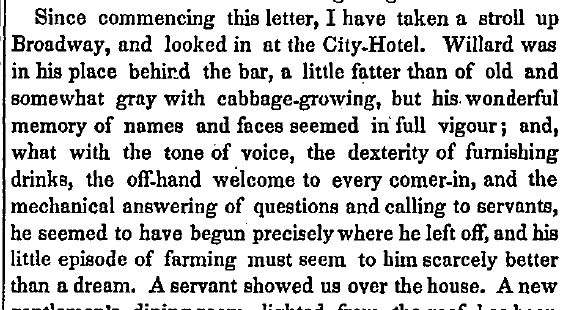A question for everyone here. I have long assumed that hotel front desks look the way they do—like long bars—because, in the past, they also did double duty functioning as actual bars. But looking into this, I can find no documentation to back this assumption up. Does anyone possess any history on this subject? Or have I just been laboring under a false assumption.
I assumed they look that way so the concierge can read a book unseen by the patrons
Unfortunately I accumulated most of my information on this 20 years ago, when I was writing Imbibe. I say unfortunately because I was working mostly on paper then–printing out articles, etc.–and that paper is all in storage. As I recall, there wasn’t a lot of explicit statement of this phenomenon; of people saying “I checked in with the clerk, who was also the bartender” or anything like that. But if you go to truly old American hotels, such as the Essex Inn in Essex, NY, on Lake Champlain, or the Mount Vernon Hotel Museum, here in New York City, you see that the bar was built as a cage, with a lockable wooden grate to close it (the Essex Inn has been renovated since I was there, so I can’t guarantee that they still had theirs. That was because it was in the lobby, without a room of its own, and it was in fact the only structure in the lobby.
When early 19th-century American advertisements suggested people call in at a hotel, for whatever reason, they would specify seeing the bar-tender or asking at the bar. E.g., this, from an 1816 Washington, DC playbill:
It should be noted that the Oxford English Dictionary doesn’t have an entry for “hotel clerk” before 1850 (I’ve found it from 1830, but in Ireland, not the US).
What one does see is ads for “barkeeper[s] for hotel[s],” implying that that was a different kind of barkeeper than the ordinary tavern type.
It’s clear from the various surviving accounts of Orsamus Willard, of New York’s City Hotel, that he both mixed drinks and performed all the functions of a hotel clerk, including receiving the guests. E.g., this, from 1843, when Willard andd his partner Chester Jennings resumed managing the hotel after retiring for a couple of years:
It wasn’t until the 1830s that hotels began removing the bar from the reception area, putting it behind closable doors where the temperance advocates and the delicate types who objected to coarse, drunken talk and behavior didn’t have to wade through it to collect their mail or get their key. The Astor House, a few blocks up Broadway from the City Hotel, was a pioneer in this regard.
If it would be helpful, I can dig some of this material out of my storage space the next time I’m there.
[Edited because I left out a “bar.”]
Very interesting, David. Thank you for all this. I must visit the Essex Inn!
I hope they’ve kept the old gated bar. Last time I was there was nigh on 20 years ago, but it had been there since 1812, so…

